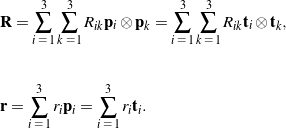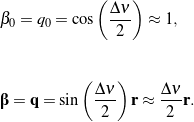An infinitesimal rotation is defined as a rotation about an axis ![]() through an angle
through an angle ![]() that is very small:
that is very small: ![]() , where
, where ![]() [1]. Rotations of this type play a role in defining stiffness matrices (see [2] and references therein) and in numerical schemes that feature incremental updates to rotations and angular velocities (e.g., see [3]). Infinitesimal rotations differ from their finite counterparts in the simplicity of their representation and in the fact that the composition of infinitesimal rotations is commutative.
[1]. Rotations of this type play a role in defining stiffness matrices (see [2] and references therein) and in numerical schemes that feature incremental updates to rotations and angular velocities (e.g., see [3]). Infinitesimal rotations differ from their finite counterparts in the simplicity of their representation and in the fact that the composition of infinitesimal rotations is commutative.
Contents
Euler’s representation
From the assumptions on the smallness of the angle of rotation ![]() , it follows that
, it follows that
(1) 
There is no corresponding smallness restriction on the axis of rotation ![]() . With the help of (1), we find that if
. With the help of (1), we find that if ![]() is the rotation tensor for an infinitesimal rotation, then Euler’s representation simplifies to
is the rotation tensor for an infinitesimal rotation, then Euler’s representation simplifies to
(2) ![]()
where the skew-symmetric tensor ![]() is obtained from the rotation vector
is obtained from the rotation vector ![]() :
:
(3) ![]()
That is, the axial vector of ![]() is
is ![]() . The representation (2) is also easily established from the exponential map representation of a rotation tensor. It is also interesting to note that the inverse of an infinitesimal rotation has the simple representation
. The representation (2) is also easily established from the exponential map representation of a rotation tensor. It is also interesting to note that the inverse of an infinitesimal rotation has the simple representation ![]() . In matrix form, the infinitesimal rotation (2) has the representation
. In matrix form, the infinitesimal rotation (2) has the representation
(4) ![Rendered by QuickLaTeX.com \begin{equation*} \mathsf{R} = \left[ \begin{array}{c c c} R_{11} & R_{12} & R_{13} \\ R_{21} & R_{22} & R_{23} \\ R_{31} & R_{32} & R_{33} \end{array} \right] = \left[\begin{array}{c c c} 1 & 0 & 0 \\ 0 & 1 & 0 \\ 0 & 0 & 1 \end{array} \right] + \Delta\nu \left[ \begin{array}{c c c} 0 & - r_3 & r_2 \\ r_3 & 0 & - r_1 \\ - r_2 & r_1 & 0 \end{array} \right] , \hspace{1in} \scalebox{0.001}{\textrm{\textcolor{white}{.}}} \end{equation*}](https://rotations.berkeley.edu/wp-content/ql-cache/quicklatex.com-1cf1bcc251984c81cb8a556e0f516410_l3.png)
where ![]()
![]() and
and
(5) 
To first order in ![]() , it can be shown from (2) that
, it can be shown from (2) that ![]() . Consequently, for infinitesimal rotations, the distinction between these two sets of basis vectors is typically ignored, a feature which is useful when considering the composition of infinitesimal rotations.
. Consequently, for infinitesimal rotations, the distinction between these two sets of basis vectors is typically ignored, a feature which is useful when considering the composition of infinitesimal rotations.
The Euler angle representation
From either of the representations (2) or (4), it follows in a straightforward manner that the composition of two infinitesimal rotations is commutative. As a result, suppose we have three infinitesimal rotations about three axes:
(6) ![Rendered by QuickLaTeX.com \begin{eqnarray*} {\bf R} \!\!\!\!\! &=& \!\!\!\!\! {\bf L}\left(\Delta\phi, \, {\bf a}_1\right) {\bf L}\left(\Delta\theta, \, {\bf a}_2\right) {\bf L}\left(\Delta\psi, \, {\bf a}_3\right) \\[0.10in] &=& \!\!\!\!\! {\bf I} + \Delta\phi \,\, \mbox{skewt}\left({\bf a}_1\right) + \Delta\theta\,\, \mbox{skewt}\left({\bf a}_2\right) + \Delta\psi \,\, \mbox{skewt}\left({\bf a}_3\right). \end{eqnarray*}](https://rotations.berkeley.edu/wp-content/ql-cache/quicklatex.com-b768fee3cda1cff3a2d7a36534da211f_l3.png)
Assuming ![]() are mutually orthogonal (i.e.,
are mutually orthogonal (i.e., ![]() ), we see from (4) that the matrix representation for the resulting compound rotation is
), we see from (4) that the matrix representation for the resulting compound rotation is
(7) ![Rendered by QuickLaTeX.com \begin{equation*} \mathsf{R} = \left[ \begin{array}{c c c} 1 & 0 & 0 \\ 0 & 1 & 0 \\ 0 & 0 & 1 \end{array} \right] + \left[ \begin{array}{c c c} 0 & - \Delta\psi & \Delta\theta \\ \Delta\psi & 0 & - \Delta\phi \\ - \Delta\theta & \Delta\phi & 0 \end{array} \right]. \end{equation*}](https://rotations.berkeley.edu/wp-content/ql-cache/quicklatex.com-5d9a2a5613c8fdaa650bdb81b39270a0_l3.png)
We can use either (6) or (7) to infer the representation of an infinitesimal rotation for any one of the 12 sets of Euler angles. For example, (7) is the matrix representation for a infinitesimal rotation parameterized by a set of 3-2-1 Euler angles.
The Euler-Rodrigues and quaternion parameterizations
If a set ![]() of Euler-Rodrigues symmetric parameters or, equivalently, a unit quaternion
of Euler-Rodrigues symmetric parameters or, equivalently, a unit quaternion ![]() is used to parameterize an infinitesimal rotation, then we deduce from the developments in the section on the Euler-Rodrigues and quaternion parameterizations that
is used to parameterize an infinitesimal rotation, then we deduce from the developments in the section on the Euler-Rodrigues and quaternion parameterizations that
(8) 
The resulting representation of the rotation tensor ![]() is a linear function of
is a linear function of ![]() :
:
(9) ![Rendered by QuickLaTeX.com \begin{eqnarray*} {\bf R} \!\!\!\!\! &=& \!\!\!\!\! {\bf I} + 2 \, \mbox{skewt}\left({\bbeta}\right) \\[0.10in] &=& \!\!\!\!\! {\bf I} + 2 \, \mbox{skewt}\left({\bf q}\right) . \end{eqnarray*}](https://rotations.berkeley.edu/wp-content/ql-cache/quicklatex.com-1adce32459b4c605094a030c06a50070_l3.png)
The matrix representation of this expression is easily inferred from (4). For example, in terms of ![]() ,
,
(10) ![Rendered by QuickLaTeX.com \begin{equation*} \mathsf{R} = \left[ \begin{array}{c c c} 1 & 0 & 0 \\ 0 & 1 & 0 \\ 0 & 0 & 1 \end{array} \right] + 2 \left[ \begin{array}{c c c} 0 & - q_3 & q_2 \\ q_3 & 0 & - q_1 \\ - q_2 & q_1 & 0 \end{array} \right]. \end{equation*}](https://rotations.berkeley.edu/wp-content/ql-cache/quicklatex.com-94260858e76076dcb6a751cee2bfc1a6_l3.png)
References
- Shuster, M. D., A survey of attitude representations, Journal of the Astronautical Sciences 41(4) 439–517 (1993).
- Metzger, M. F., Faruk Senan, N. A., and O’Reilly, O. M., On the Cartesian stiffness matrix in rigid body dynamics: An energetic perspective, Multibody System Dynamics 24(4) 441-472 (2010).
- Simo, J. C., and Vu-Quoc, L., A three-dimensional finite-strain rod model. Part II: Computational aspects, Computer Methods in Applied Mechanics and Engineering 58(1) 79-116 (1986).